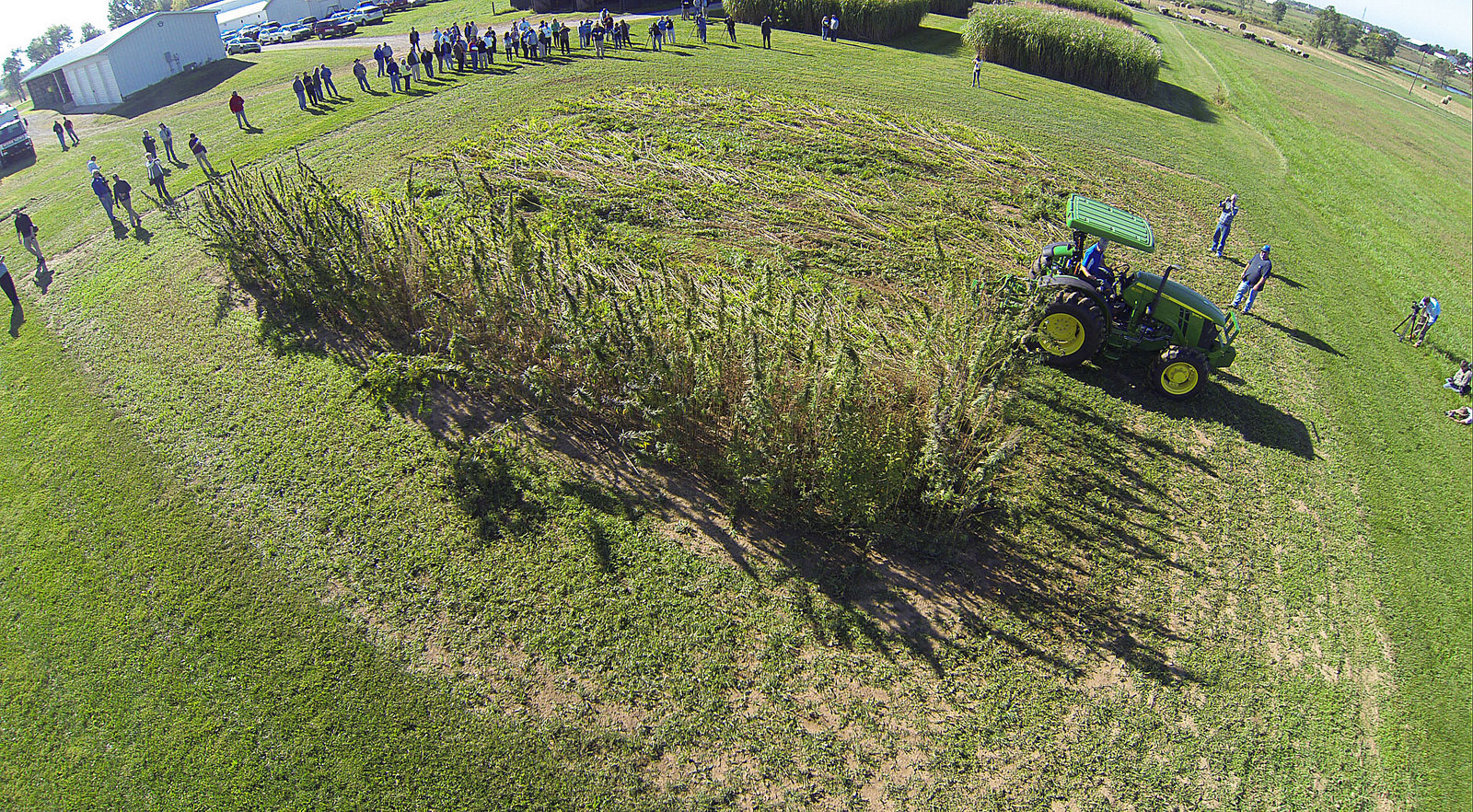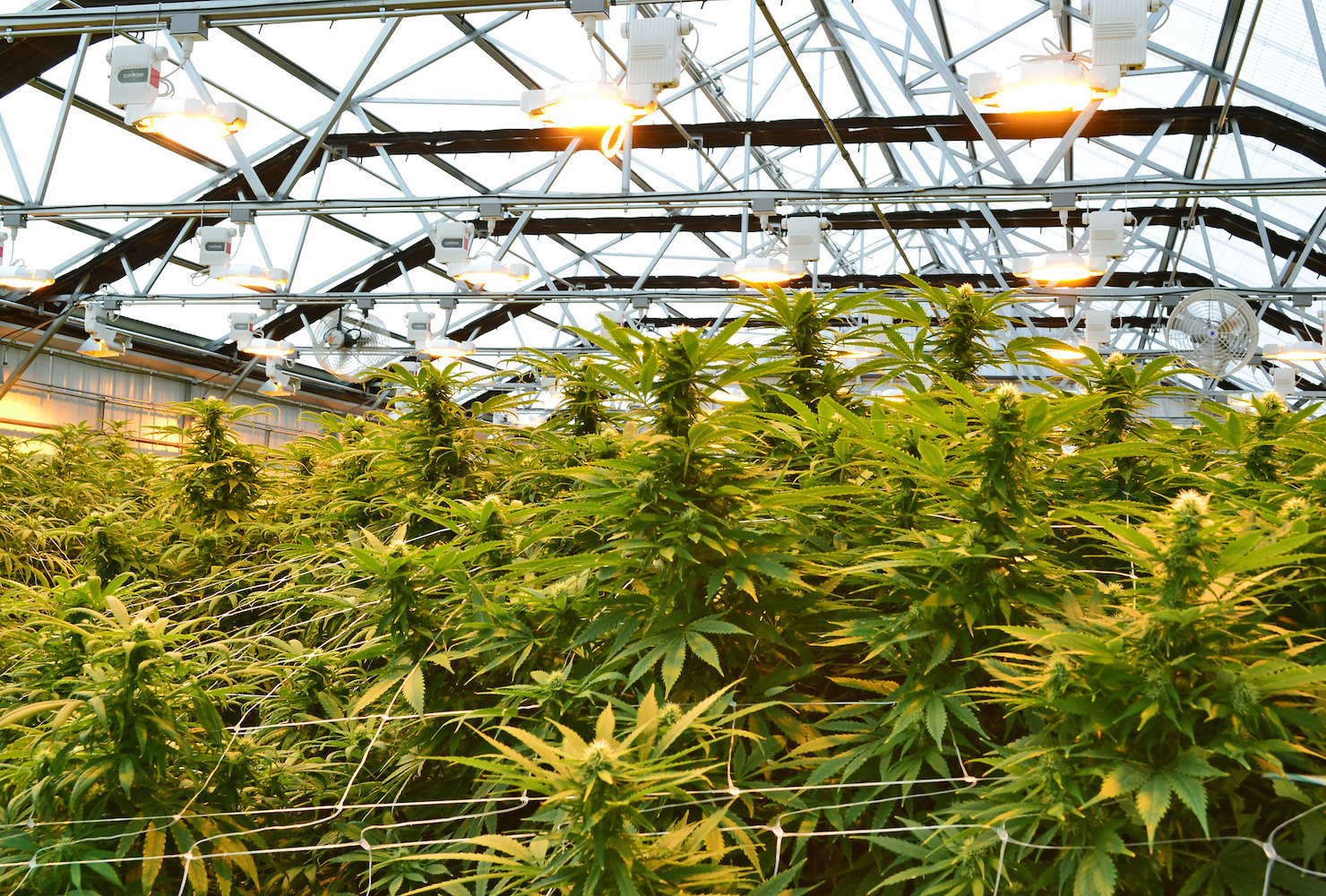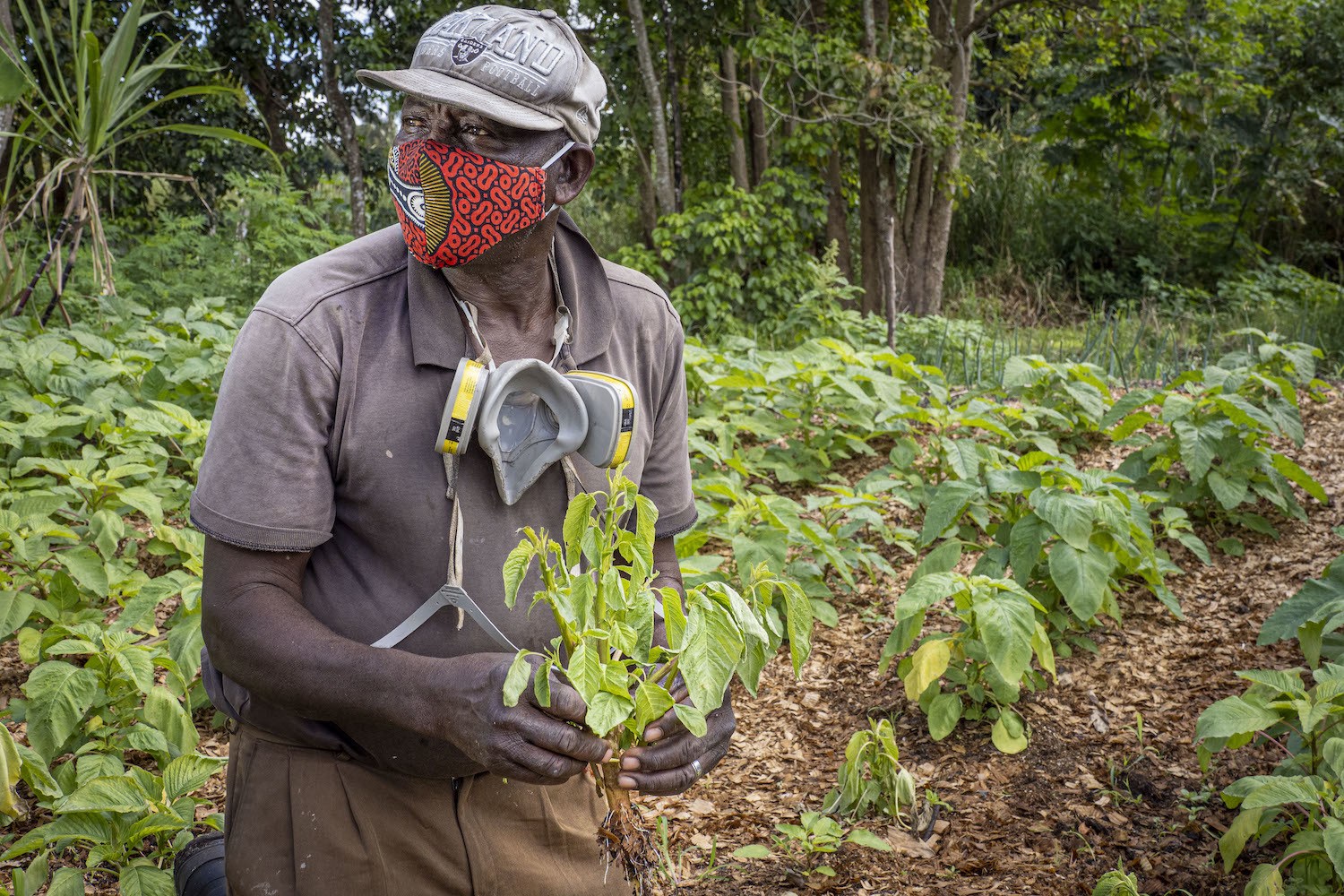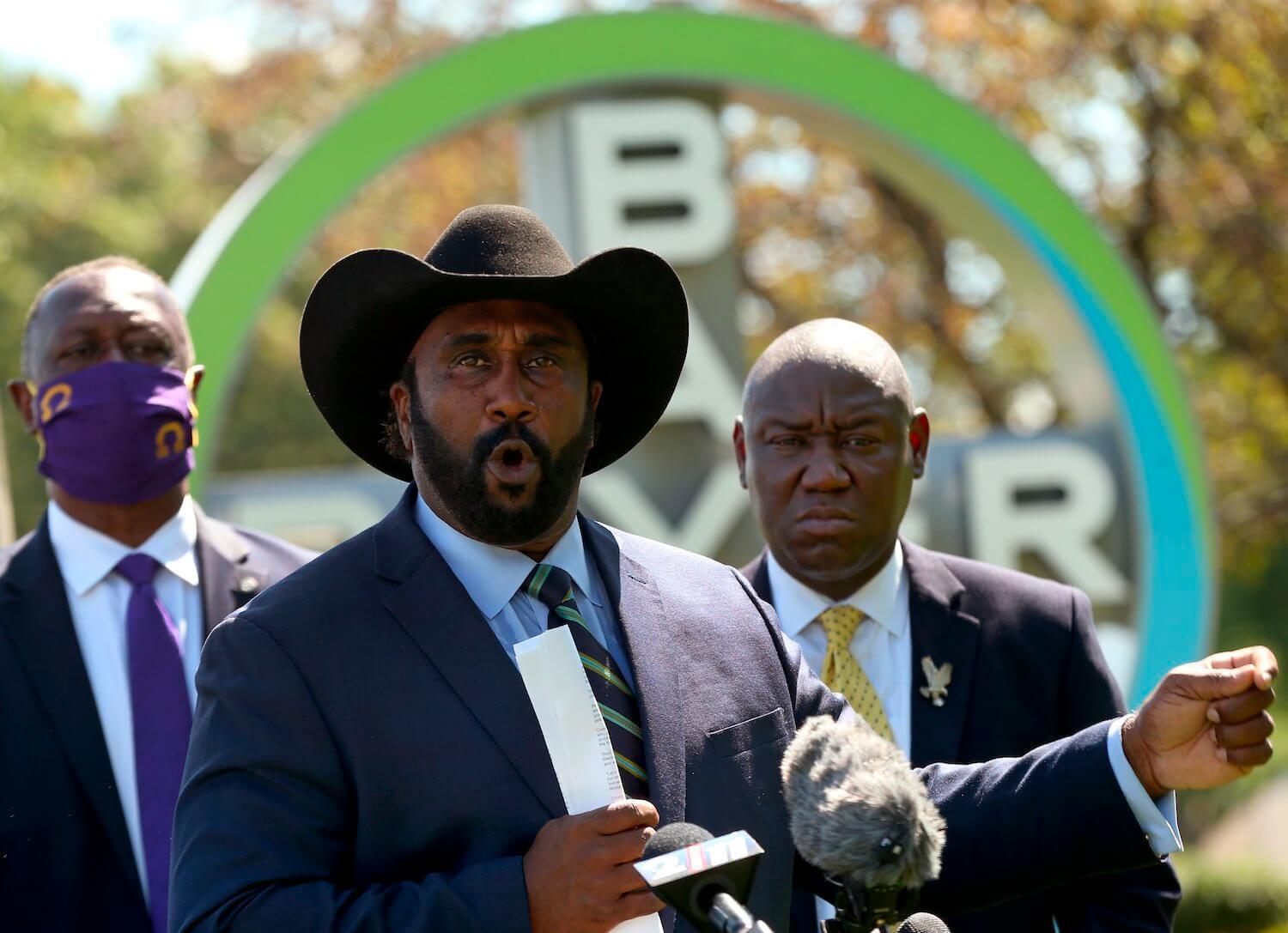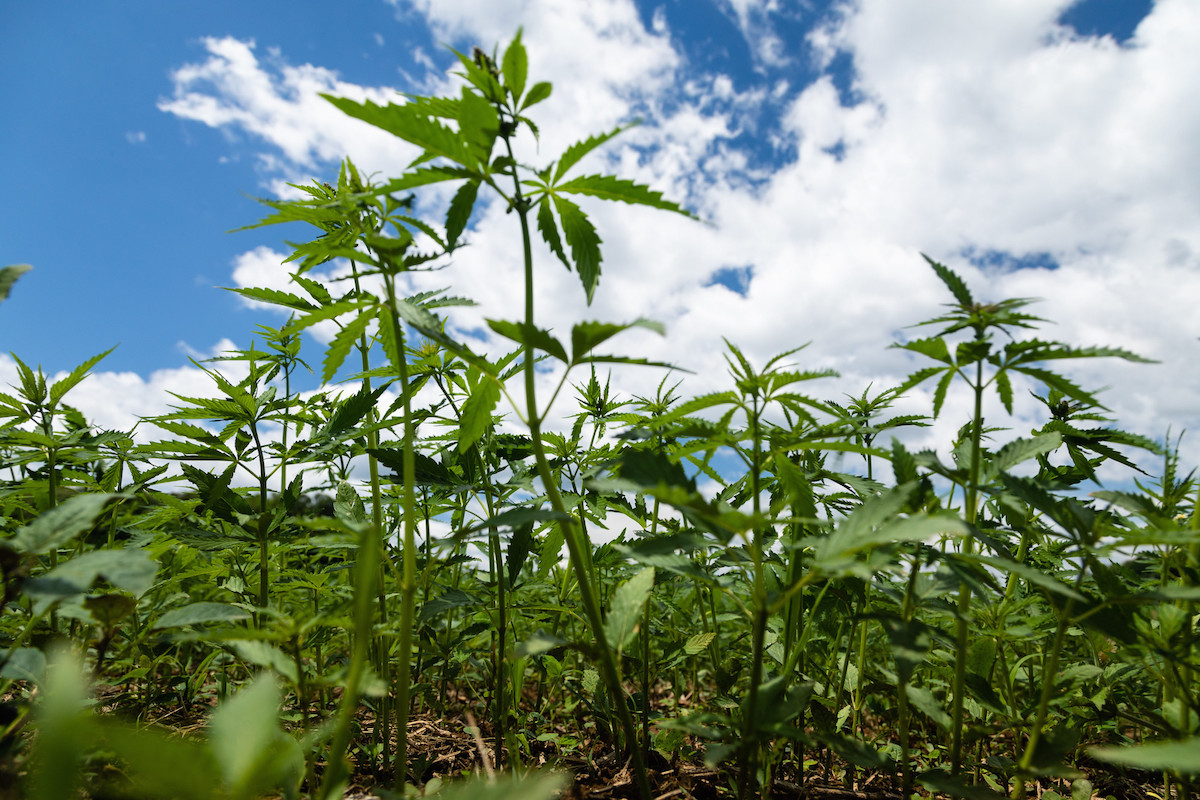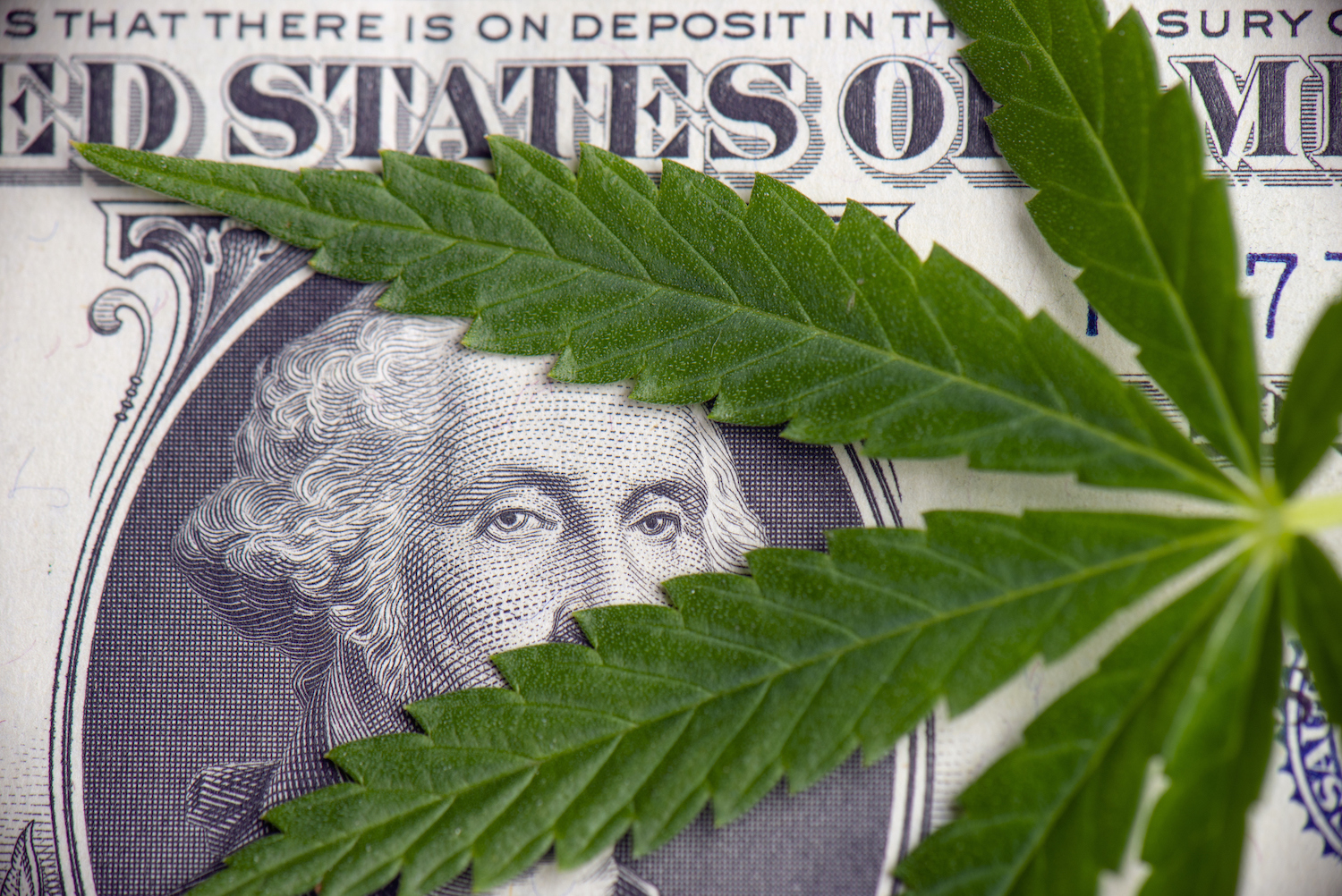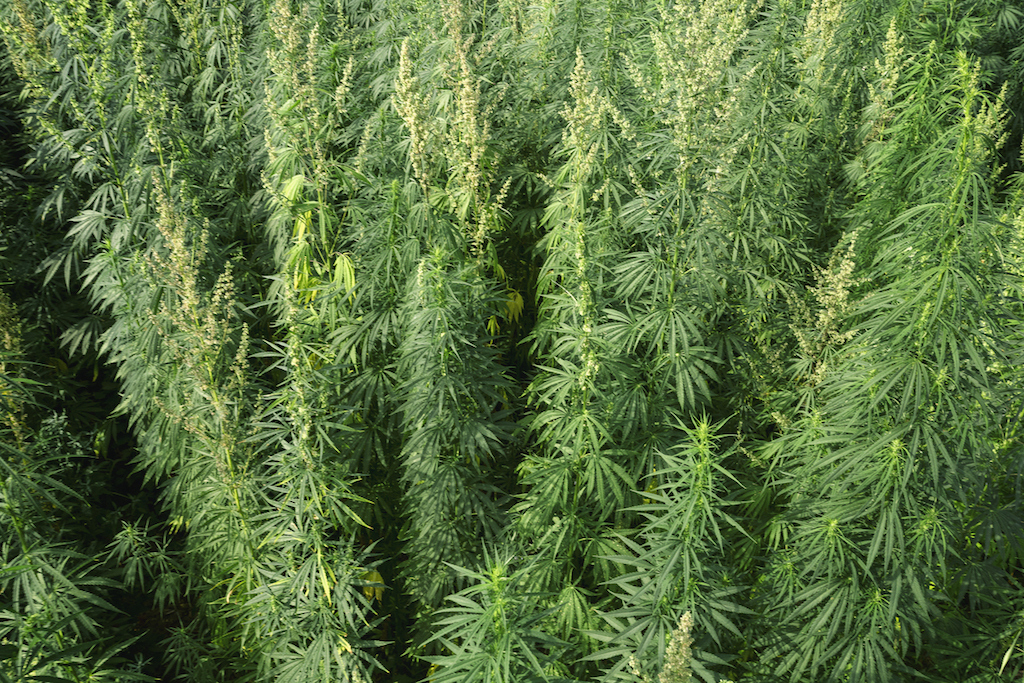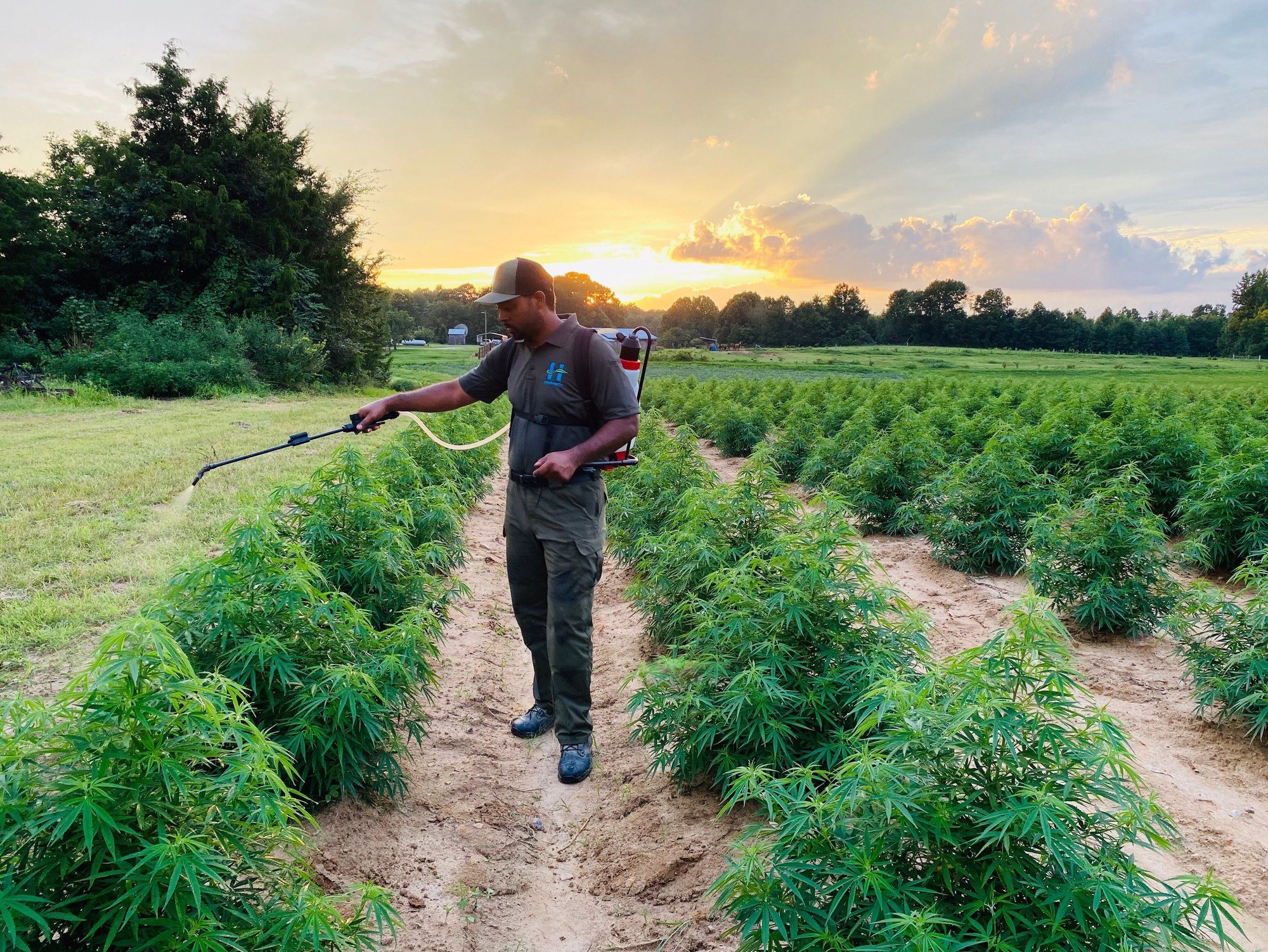
Courtesy of Patrick Brown
The challenges of navigating a developing market, emerging loan practices, and startup costs can compound existing barriers, especially for newer growers.
For North Carolina farmer Patrick Brown, hemp’s appeal lies in its ability to nourish the more than 175 acres his family has farmed since his great-grandfather, Byron, acquired land after the Civil War in 1865.
Pictured above: Patrick Brown sprays organic pesticide on hemp plants. Few herbicides have been approved for use on the plant, so weed and pest control require close attention.
Brown’s father, Arthur, planted row crops—tobacco, soybeans, and corn, among others—for more than 60 years in Henderson, a town about 40 miles from Raleigh. As pesticide and herbicide use grew nationwide, the Browns and farmers like them relied more on chemical use to reap bountiful harvests.
“Now is my time as the fourth generation to change that. My father farmed to survive. Now, I have the ability to farm to create alternatives, to create processes, to create relief. And that’s what my goal is,” said the 38-year-old.
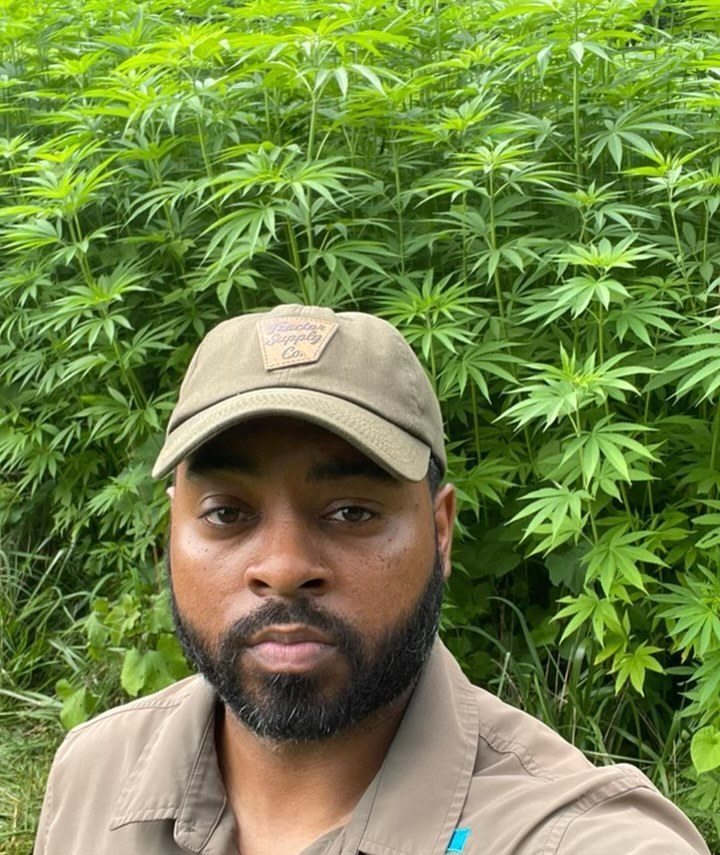
Courtesy of Patrick Brown
In his first year, Patrick Brown planted 18 acres of sungrown hemp using the no-till method, which employs a cover crop like clover or buckwheat to suppress weeds, as opposed to chemical herbicides.
While hemp presents a lucrative global market projected to top $26 billion by 2025, getting started can be a particular challenge for Black farmers, whose spotty access to loans and technical education are compounded by hemp’s labor costs, regulatory hurdles, and high risk due to upfront investment and unpredictable plant genetics.
Farmers like Leon Moses, who supervises the historically Black North Carolina Agricultural and Technical (A&T) State University’s 492-acre farm system, have been pushing for states to collect and release ethnic data on who is farming hemp. North Carolina, for example, does not capture demographic data on state-licensed hemp growers, and industrywide statistics are difficult to pin down. Moses said the school’s annual farm field day hosts about 350 attendees; of those participants, who are mostly farmers of color or of limited resources, he figures about 5 percent are hemp producers.
After North Carolina authorized its state pilot hemp program under the 2014 Farm Bill, N.C. A&T began growing the crop for research two years later. In those first few years, Moses said he received daily calls from farmers searching for information on how to capitalize on the crop’s growing popularity. When prices began to tumble in 2018 and 2019 due to surplus and inundated processors—whose logjams caused many producers to be left holding unbought, deteriorating product—that interest took a nosedive.
Despite many small farmers’ dreams that hemp would be the crop to boost their productivity and profit, Moses remains cautious about its outsized potential for these farmers. Traditional commodities tend to have lower startup costs; for example, though corn seed prices are trending upward, the U.S. Department of Agriculture’s (USDA) Economic Research Service estimates that corn seed usually costs farmers about $100 per acre.
“In North Carolina, hemp has a very finicky market. A lot of things can put you in a place where you’re jeopardizing a lot of your money based on a hope.”
By comparison, he said, “With hemp, just the initial investment for purchasing plants could be $5,000 per acre.”
He continued: “In North Carolina, hemp has a very finicky market. A lot of things can put you in a place where you’re jeopardizing a lot of your money based on a hope,” said Moses. And most Black farmers don’t have the resources to take that gamble.
As an experienced farmer whose late mother schooled him on plant genetics, Brown had a head start on other new hemp farmers. He views industrial hemp as an entry point to regenerative agriculture. Since 2017, Brown Family Farms has grown hemp with the intention of phasing out traditional commodities and rehabilitating their family land, stripped of nutrients by cash crops. Some studies suggest that hemp plants can improve soil health and trap carbon—a key priority for the Biden administration’s USDA.
In his first year, Brown planted 18 acres of sungrown hemp using the no-till method, which employs a cover crop like clover or buckwheat to suppress weeds, as opposed to chemical herbicides. In slim rows laid out with a subsoiler between the cover crop, he sowed seeds bought from a supplier into the soil. While seeds are cheaper than plant clones, they carry their own set of risks, namely that despite their certificate of analysis (COA), a farmer might not get what they paid for. Hemp is derived from the same plant as marijuana, but its chemical compound, CBD, does not produce the psychotropic side effects or “high” that comes from THC, though both occur naturally in cannabis.
He found the hemp growing process as straightforward as any other plant. It was resilient and easy to maintain, and he found that it gave a grower optimal time to correct deficiencies, such as a lack of water or proper nutrients. But weeding and pest control were much more labor-intensive. “You have to tend to it more often,” Brown said.
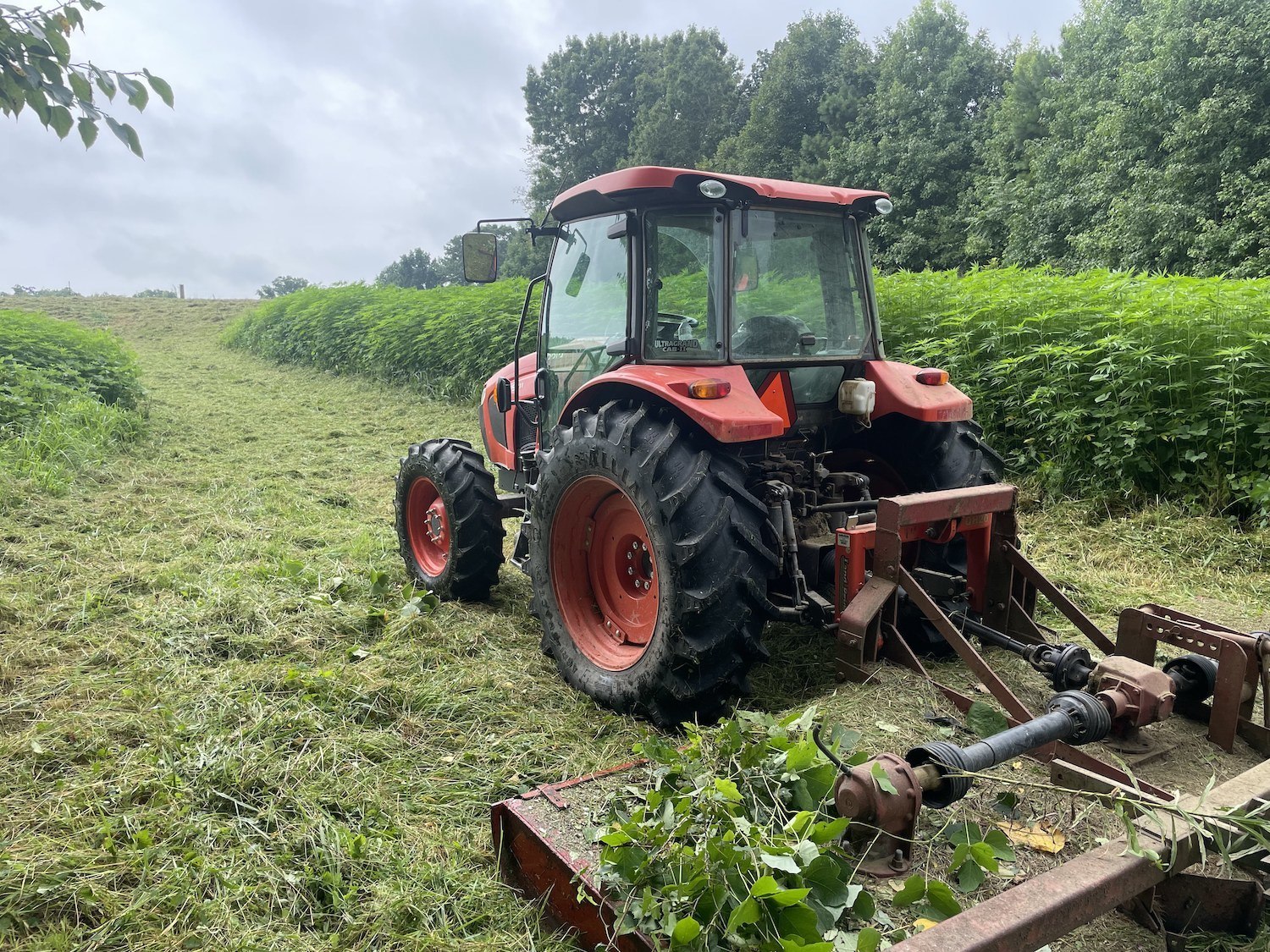
With better access to federal grants, funding, and technical support, as well as overall industry reform to mitigate the high risk farmers face when undertaking the crop, Black hemp farmers and advocates believe the reward could outweigh the risks.
Courtesy of Patrick Brown
Hemp plants, which can grow up to 6 feet tall at harvest, require almost-daily care. Few herbicides or pesticides have been approved for use on the plant, so weed and pest control require close attention. While there are specially designed machines to harvest hemp, many small farmers cut the dense stalks by hand to avoid added equipment costs.
Since his first year planting hemp, Brown’s increased his operation to 165 acres. The hemp harvested from Brown’s cannabis plants are sold for fiber, grain, flower, and oil, which the farm processes and uses to make CBD products like tinctures, salves, and teas sold online and in a Warrenton, North Carolina, retail store under the name Hempfinity. He sells the bulk of his crop, though, to V. F. Corporation, owner of outdoor apparel company The North Face and other retail brands.
Brown, who works an off-farm job as a federal police officer, reorganized the farm to prepare for hemp production. He implemented new crop rotations and planted organic vegetables and medicinal herbs such as lavender, eucalyptus, and basil—crops he felt had monetary and regenerative value. Setting up the farm for transition cost him about $150,000 spent on equipment—harvesters, a new closed cab tractor for all weather conditions—and interior structures such as the farm’s three greenhouses and a temperature-controlled storage facility.
Although 2018’s Farm Bill legalized industrial hemp, cannabis containing more than .3 percent of THC remains a federally controlled substance. Hemp producers run the added risk of cannabis plants running “hot”—a phenomenon that occurs when a plant’s THC content exceeds the federal compliance level, putting the producer at risk of losing a significant portion, if not all of their crop.
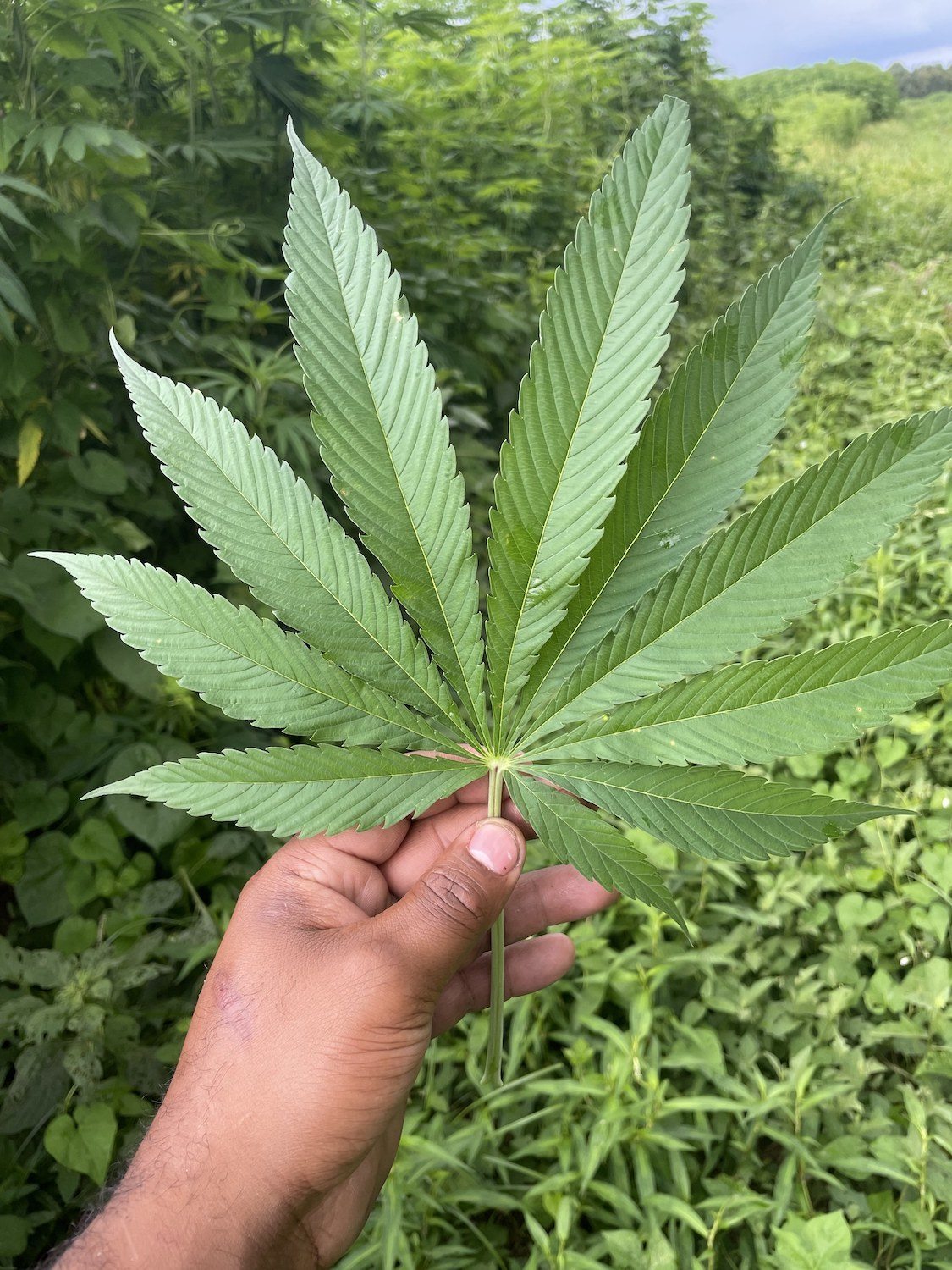
Hemp plants, which can grow up to 6 feet tall at harvest, require care almost daily.
Courtesy of Patrick Brown
This means that farmers must pay to lab-test their crops early and often to determine THC levels, as all growers must receive a state-approved COA before they can be harvested and sold. This factor has made private banks and lenders leery of financing hemp operations, and the USDA has only this year issued guidance to its Farm Service Agency about processing loans for industrial hemp. So practically speaking, growers looking to get into the game early had to have cash in hand and be able to weather even more uncertainty.
Despite ongoing efforts to make USDA policy and practices more equitable, just last year, the agency rejected loans to Black farmers at three times the rate of white farmers, according to its own data. It approved only 37 percent of Black loan applicants for a USDA program to help farmers finance land, equipment, and repairs in 2020, yet granted loans to 71 percent of white farmers, according to a Politico analysis of the agency’s figures.
Mia Darden, 55, and Roy Pope, 41, self-financed their two-year-old hemp operation, Kind Origin Pharms, in Toney, Alabama, by using their off-farm incomes and dipping into their retirement plans. This year, they received some funding from one small investor.
The two friends met while working for the U.S. Department of Defense (both are still employed by the agency) and followed hemp and medical marijuana legalization in different states, hoping that Alabama would eventually do the same. In 2016, the state established a program that allowed industrial hemp to be grown for research and pilot studies. Then, in October 2019, it began accepting applications from producers looking to farm the crop as an agricultural commodity.
Darden and Pope like hemp’s versatility; according to a Congressional Research Service paper, more than 25,000 end products can be developed from the plant. They’d also heard it celebrated as a crop that can yield substantial profit with little acreage. That’s a boon to Black farmers, who cultivate less than 150 acres on average.
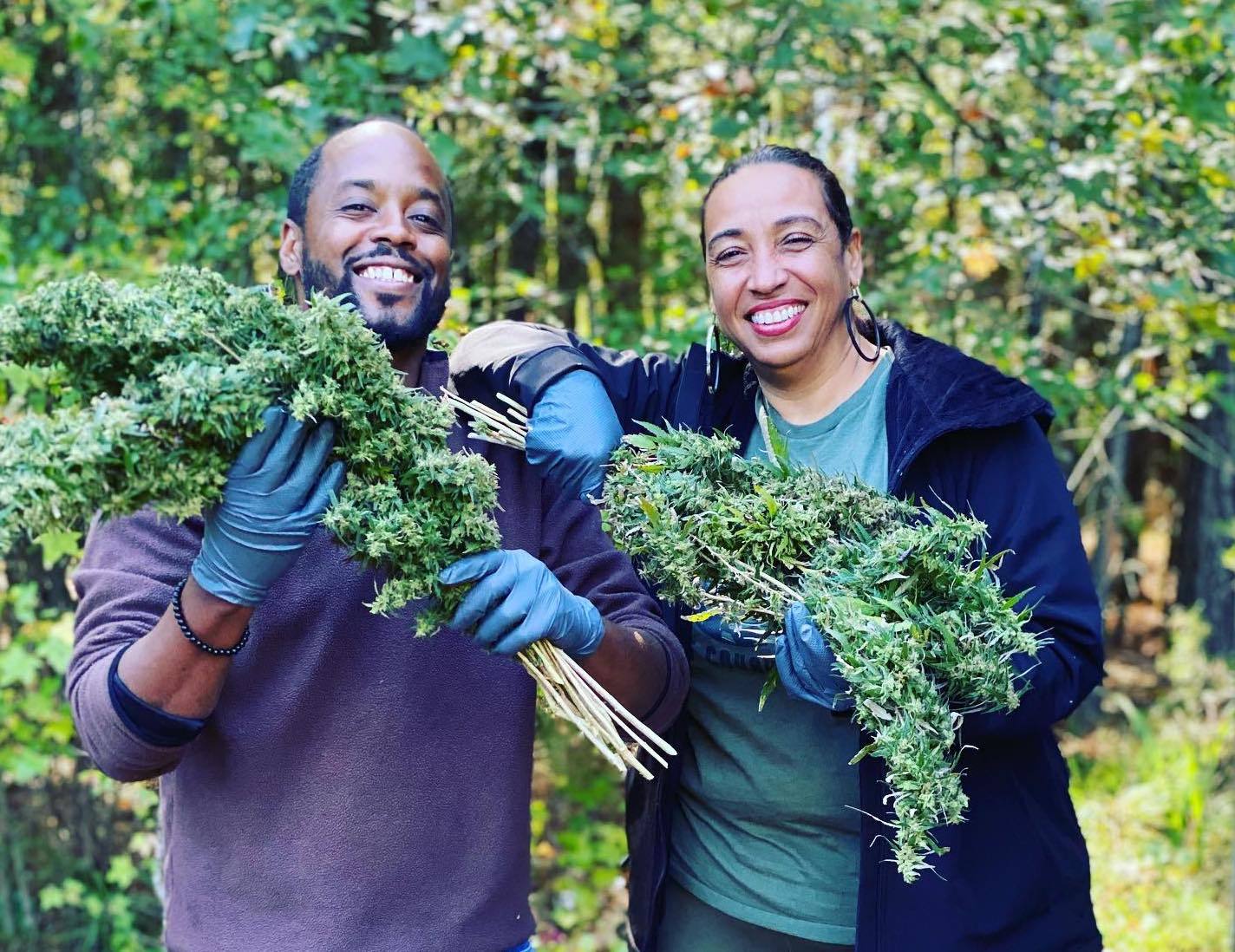
Roy Pope (left), and Mia Darden (right), holding harvested hemp at Kind Origin Pharms in Toney, Alabama.
Like Brown, Pope was able to take advantage of access to family land. He carved out about an acre and a half of his parents’ 17 acres for the industrial hemp operation. But, unlike Brown, Darden and Pope had no real experience farming full-time: no equipment on hand, no established history of farm production to access lines of credit; and no long-standing connections with knowledgeable farmers who might enlighten them along the way.
They learned as they grew. They first considered growing fiber but recognized that it was better suited for farmers with more land. Then they mulled over CBD oil.
“We realized that if we’re going to grow to manufacture oil, then we’ve got to have oil-processing capability. And we didn’t know many people around here who were doing that. We never found a really solid, established oil processor here,” said Pope.
Even when the partners reached out to processors recommended to them by the state agricultural department or other growers, those processors were also just starting out. Darden and Pope settled on CBD flower—which only needed to be dried and cured—a product already familiar to many consumers and one they believed could command a high value.
“We realized that if we’re going to grow to manufacture oil, then we’ve got to have oil-processing capability. And we didn’t know many people around here who were doing that. We never found a really solid, established oil processor here.”
Most Black producers lack on-site processing and storage facilities, which amounts to added costs, following the necessities like equipment, fertilizer, and seeds or plant clones. The nearest processor may not even be in the same state, and farmers can wait months for a processing appointment while prices change.
After harvest, the cannabis plant must be hung to dry in a temperature-controlled environment. Once the flowers are trimmed, they can be stored for up to two years, which a grower might choose to do if, for example, the demand or price for hemp wanes, or their full crop isn’t purchased. In some states like Florida, freezing a crop is considered processing and requires a fee-based permit.
As regulations vary from state-to-state, in Alabama, hemp producers must pay $1,000 annually for each growing, processing, or handling site. That includes a greenhouse or indoor structure. For Pope and Darden, that was an unanticipated cost they only learned of when attending a local cannabis agriculture meeting. They hope to add a greenhouse on-site to increase quality control, but in the meantime, they rent a Conex shipping container where they store and dry their plants after harvest.
The nascent character of the hemp industry meant Pope and Darden often felt as if the state’s agriculture department was like them, learning as the program progressed. That’s a sentiment echoed by Moses, the N.C. A&T farm superintendent. Because farmers and universities in North Carolina were granted the opportunity to farm hemp simultaneously, Moses believes that created a significant knowledge gap.
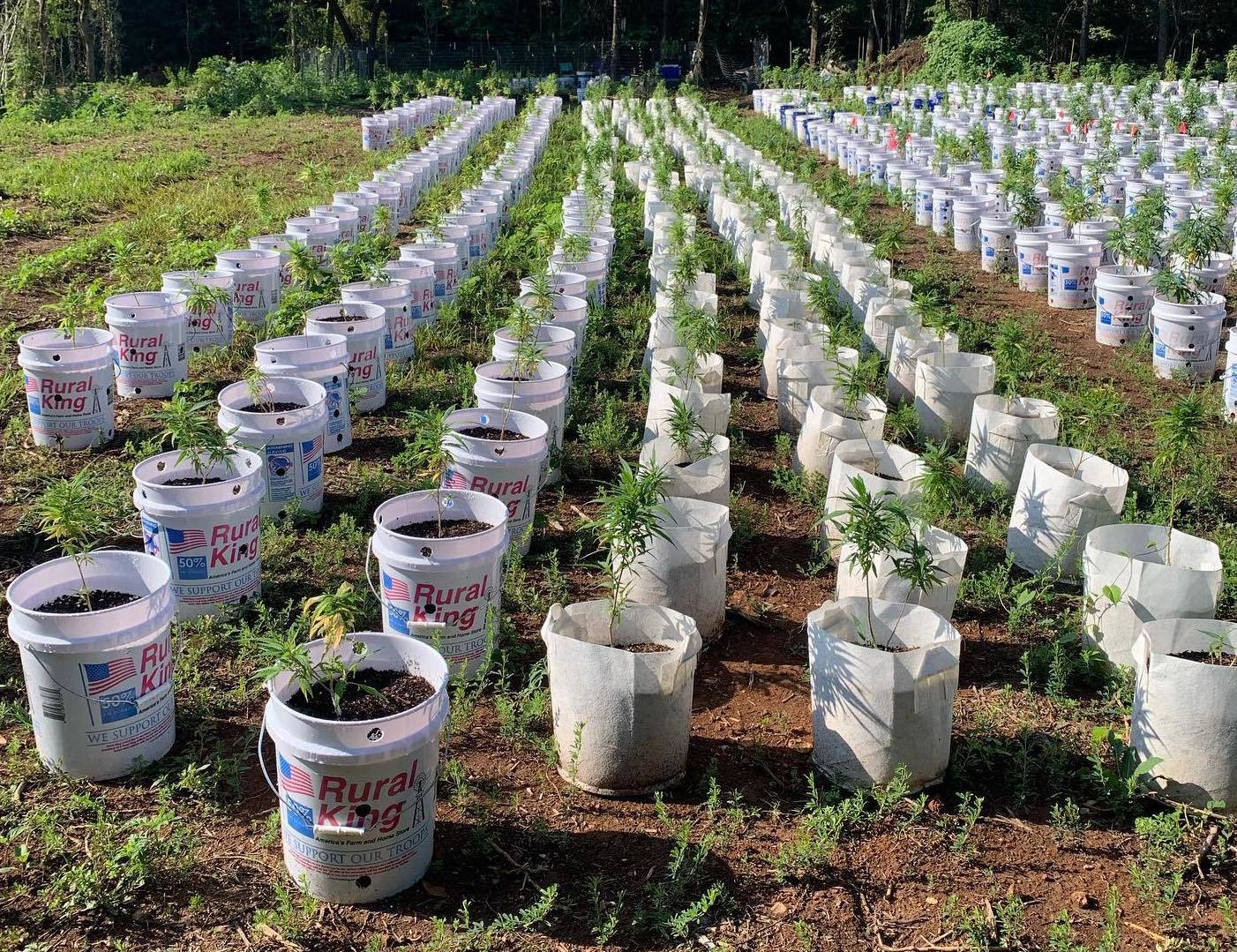
Roy Pope was able to take advantage of access to family land. He carved out about an acre and a half of his parents’ 17 acres for the industrial hemp operation.
“Universities should have been given funding to study hemp for a five-year period and develop programs and projects, so that they could truly evaluate hemp and be able to pass on qualified information to farmers so that they’d be able to know what the best practices are; what you can expect; how much fertilizer you need; what’s the best environment; how much you’re really going to make. Those things were discovered along the way,” he said.
Across the industry, that’s left room for dubious actors to take advantage of newcomers.
“Overall, everyone has said to me that market contracts are bogus,” said 38-year-old Rougemont, North Carolina farmer Amber Burgin-Brothers.
Burgin-Brothers formed her nonprofit farm, Elijah’s Educational Promise, in the fall of 2019 with the aim of securing a hemp grower’s license and planting her first crop in the new year. However, she soon learned the state required all applicants have one full year as a “bonafide farmer” under their belt before approval.
Frustrated, but undeterred, she decided to dig in, literally transitioning from the gardening she’d known and loved all her life, to full-fledged farming. She found a 10-acre property with a house outside of Durham and moved there. Burgin-Brothers worked three jobs to fund her farm enterprise and even started a GoFundMe to crowdsource donations.
“What I would like to see in the future is for the USDA to include hemp under the Perishable Agricultural Commodities Act. So that we know that people who are intending to be brokers have been vetted by the USDA.”
The pandemic delayed her plan to reapply for a hemp license in 2020, but it gave her ample time to connect with established hemp farmers, research, and identify some of the industry’s shortcomings, among them limiting contracts. Agricultural advocates like Moses recommend all farmers enlist the aid of a lawyer to review purchasing contracts, as the dollar amount may be attractive, while its terms are not.
Burgin-Brothers is wary of buyers who “expect you to sign a contract with a company who’s going to potentially purchase your hemp. And in that potential purchase risk, you also sign away the right to sell it outside of that contract. So you grow this hemp and you’re also responsible for the curing of this hemp. Then when they come to see the hemp, they might say, ‘Well, this is not up to standard. You didn’t properly cure this, and we’re not going to buy it’ or that they’ll only pay a lower price. You may have signed the original contract for $100,000. Then when you finish, you get $30,000.”
There are even more horror stories: brokers never showing up to collect the agreed-upon product or slowing payments in hopes that the market price will tumble.
Florida cannabis, agricultural, and dietary supplement attorney Scheril Murray Powell has seen all these issues play out in an industry that one advocate has called “a wild new frontier for American farmers.” Hemp’s potentially high value and intensive cultivation process—including the costs of installing irrigation and the time required to properly tend it—magnify the issue of predatory contracts in an industry that’s not backed by government subsidies.
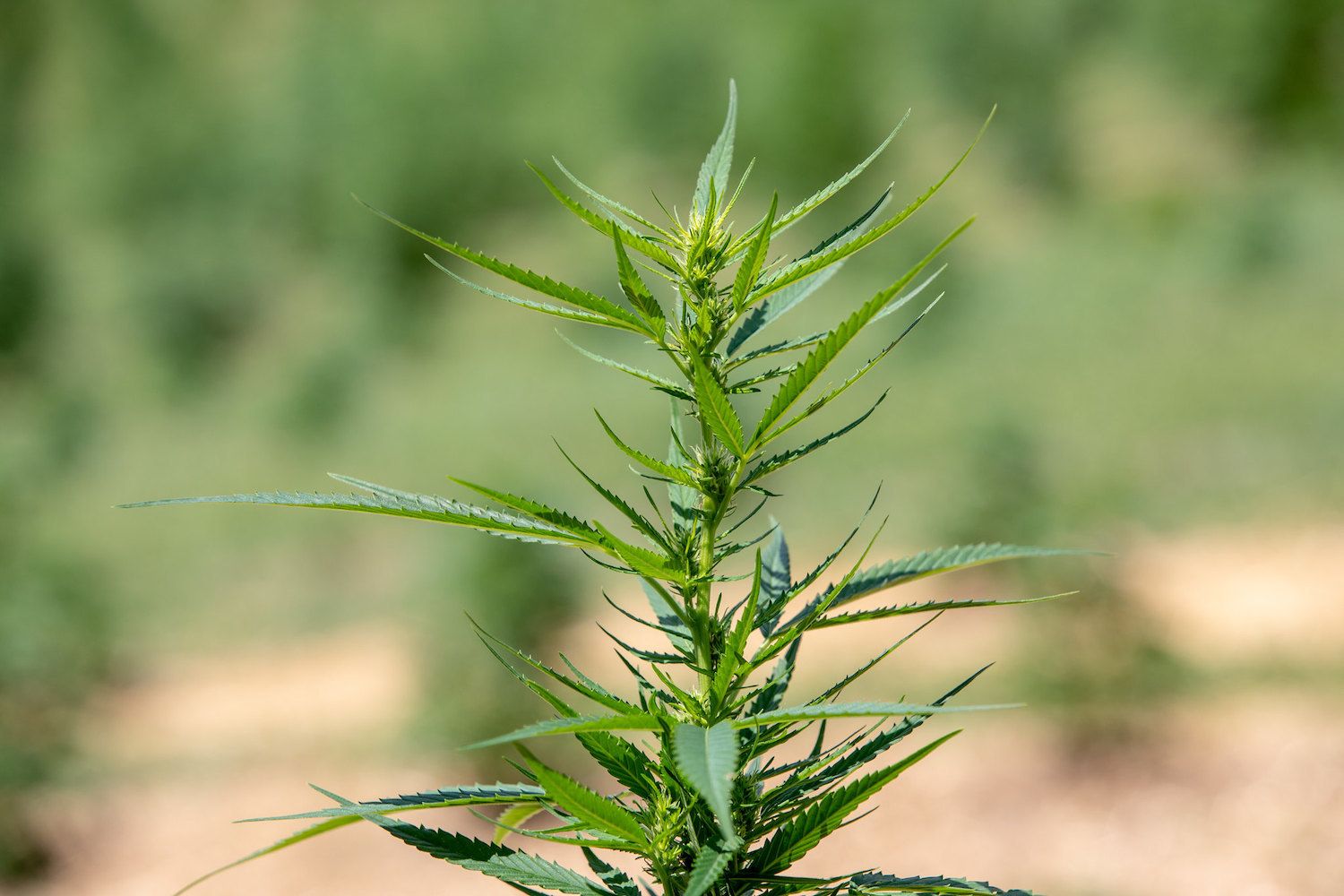
Although 2018’s Farm Bill legalized industrial hemp, cannabis containing more than .3% of THC remains a federally controlled substance.
Flickr/Governor Tom WolfThe USDA’s Risk Management Agency began offering multi-peril crop insurance coverage—policies that cover loss of crop yields from natural causes such as drought, freezes, and disease—for hemp grown for fiber, grain, or CBD oil through a pilot program covering select counties in 21 states in late 2019. This year, the agency added counties in four more. However, that insurance doesn’t cover fraud from unscrupulous brokers.
“What I would like to see in the future is for the USDA to include hemp under the Perishable Agricultural Commodities Act. So that we know that people who are intending to be brokers have been vetted by the USDA. If they’re not being honest, if they’re not showing up for their crops, then there’s going to be some sanction or some type of remedy that needs to take place,” said Murray Powell.
The federal law enacted in 1930 established regulations and mechanisms to ensure that fruit and vegetable producers and buyers engage in fair trade business practices. It provides automatic terms that both parties must abide by, as well as procedures for either to file complaints and mediate disputes.
Beyond the absence of a federal protection mechanism, Murray Powell said some legislative policies also adversely affect Black and small farmers’ ability to capitalize on hemp. Some states may require growers acquire a surety bond that guarantees monetary payment should they fail to fulfill a contract, an obvious economic hurdle for Black farmers who often possess less capital and assets than white farmers.
“Even if you have a low-cost growing license, but the processing license is high, then you make the farmer dependent on the processor to pick them, especially in jurisdictions without cottage industry law.”
Permit pricing for processing is another issue, said Murray Powell.
“Even if you have a low-cost growing license, but the processing license is high, then you make the farmer dependent on the processor to pick them, especially in jurisdictions without cottage industry law.”
In some states, hemp is excluded from cottage industry laws that enable entrepreneurs, including small farmers, to sell value-added products and foods from their homes or local farmers’ markets if their annual revenue falls below a certain threshold.
“Whereas with another commodity, you can make a salve, you can make a tincture, you can make a product … and if they’re growing those crops in small quantities, it doesn’t rot. … With hemp, you can grow for a whole season and then if you don’t have a purchaser who has a processor license, or if you can’t afford a processor license and the processing equipment, there’s nothing for you to do except sell your hemp for pennies on the dollar,” she said.
Black hemp farmers and advocates like Moses believe the reward could outweigh the risks, if there were better access to federal grants, other funding, and technical support, along with industry reform to mitigate risks. But those are big ifs, dependent on policy and cultural shifts at institutions such as the USDA, which has a long history of bias against Black farmers.
“The government has to step in and address these disparities,” said Moses of N.C. A&T. “We need to make available loans, grants—try to level the playing field. Give them an opportunity to buy machinery, to buy plants. … The systemic discrimination against the Black farmer has to stop.”

